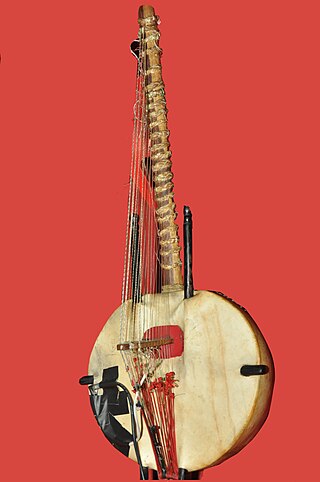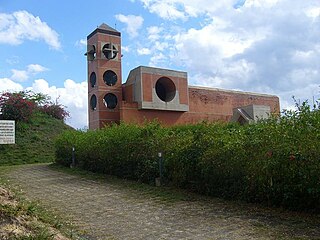
The kora is a stringed instrument used extensively in West Africa. A kora typically has 21 strings, which are played by plucking with the fingers. It combines features of the lute and harp.

Solesmes Abbey or St. Peter's Abbey, Solesmes is a Benedictine monastery in Solesmes, Sarthe, France, famous as the source of the restoration of Benedictine monastic life in the country under Dom Prosper Guéranger after the French Revolution. The current abbot is the Right Reverend Dom Abbot Geoffrey Kemlin, O.S.B., elected in 2022.

The Solesmes Congregation is an association of monasteries within the Benedictine Confederation headed by the Abbey of Solesmes.
St. Cecilia's Abbey, Solesmes is a Benedictine monastery of nuns, founded in 1866 by Dom Prosper Guéranger, the restorer of Benedictine life in France after the destruction of the revolution. It is located in Solesmes, Sarthe, and is the women's counterpart of Solesmes Abbey.

San José Abbey, Güigüe, Venezuela, is a Benedictine abbey of the Congregation of Missionary Benedictines of Saint Ottilien. Currently located to the south of Lago de Valencia, the monastic community was originally established as a mission procure in Caracas following World War I. Caracas' expansion restrained the development of the abbey, and in the late 1980s the monks relocated to Güigüe. The community's superior is Fr Abbot José María Martínez Barrera.
The Abbey of Our Lady Help of Christians, Ndanda, Tanzania, is a Benedictine monastery of the Congregation of the Missionary Benedictines of Saint Ottilien. Established in 1906 as a mission station in German East Africa, the monastery is currently home to 71 monks. On 25 March 2021 the community elected Fr. Christian Temu OSB its 6th Abbot.
St Paul's Abbey, Newton, New Jersey, is a Benedictine simple priory of the Congregation of Missionary Benedictines of Saint Ottilien. Originally established as a mission procure following World War I, over time the size of the community drastically decreased. In 2002, monks from Waegwan Abbey, South Korea, took charge of the monastery. On January 25, 2004, Newton II was elevated to the status of a simple priory. The community's superior is Fr Prior Samuel Kim.
Prince of Peace Abbey, Tigoni, Nairobi Province, Kenya, is a Benedictine monastery of the Congregation of the Missionary Benedictines of Saint Ottilien. Established in 1978 at the request of Maurice Cardinal Otunga, the monastery is currently home to 50 monks. Abbot John Baptist Oese Imai is the community's superior.
Christ the King Priory, Tororo, Eastern Region, Uganda, is a Benedictine monastery of the Congregation of Missionary Benedictines of Saint Ottilien. Established in the 1980s by Fr John Neudegger, OSB, the monastery is currently home to 24 monks. Fr Prior Fidelis is the community's superior.
St Michael's Priory, Kumily, Idukki, Kerala, India, is a Benedictine monastery of the Congregation of the Missionary Benedictines of Saint Ottilien. The monastery was established in 1987 by Zacharias Kuruppacheril, an Indian secular priest. Located on the western slopes of the Cardamom Hills, around 150 km east of Kochi, the monastery is currently home to 13 monks and 6 brothers in formation. Prior Fr.John Kaippallimyalil is the community's superior.
The Abbey of St. Maurus is a Tanzanian Benedictine monastery of the Congregation of Missionary Benedictines of Saint Ottilien in Hanga, Ruvuma Region. Established in 1956 by Abbot-Bishop Eberhard Spiess as a formation house for African monastic candidates, the monastery is currently home to 122 monks. The abbey operates schools and a dispensary for the people of the local village and a seminary for the Roman Catholic Archdiocese of Songea.

Saint Maurus and Saint Placidus Abbey, Waegwan, Chilgok, North Gyeongsang, South Korea is a Benedictine monastery of the Congregation of Missionary Benedictines of Saint Ottilien. Established in 1952 by Korean monks who had survived the dissolution of the Territorial Abbey of Tokwon and Holy Cross Abbey in Yanji, the monastery is currently home to 131 monks. Fr Blasio Park is the current abbot.
The Monastery of St Odile, Malandji (Kananga), Kasaï Occidental province, Democratic Republic of the Congo, was a Benedictine monastery of the Congregation of Missionary Benedictines of Saint Ottilien. Established in Zaïre in 1990 by two members of St Ottilien Archabbey, the monastery was suppressed in 1996 during the First Congo War.
Holy Cross Abbey, Yenki (Yanji), Jilin, China, was a Benedictine monastery of the Congregation of Missionary Benedictines of Saint Ottilien. Established in 1922 as a mission station, the monastery later became the seat of the Vicariate Apostolic of Yenki. After the withdrawal of Soviet forces following World War II, the monastery was suppressed by the People's Republic of China. While many of the monks were repatriated to Europe, others moved to South Korea and founded the Abbey of Waegwan.
Abbaye Saint-Benoît de Koubri, Koubri, Kadiogo Province, Burkina Faso, is a Benedictine monastery of the Subiaco Congregation. Founded in 1961, the monastery is located around 30 km from Ouagadougou, the capital of Burkina Faso. As of 2000, the monastery was home to 27 monks, under the leadership of Abbot Fr André Ouédraogo.
St Benedict's Abbey, Pietersburg (Polokwane), Limpopo, South Africa, is a Benedictine monastery of the Subiaco Congregation. It began in 1911 as a mission territory; the community established a monastery in 1937. As an Abbey Nullius, the monastery governed what is now the Roman Catholic Diocese of Polokwane until 1989. As of 2022, the community numbers about 12 in various stages of formation monks. The community was given the Very Rev. Dominic Mohapi, OSB, as Prior Administrator on August 18, 2022.
Abbaye de l'Ascension, Dzogbégan, Plateaux Region, Togo, is a Benedictine monastery of the Subiaco Cassinese Benedictine Congregation (O.S.B). Founded by French monks in 1961, the monastery was elevated to abbatial status in 1991. As of 2022, the monastery was home to thirty monks, under the leadership of Abbot Fr Theodore Kouassis Coco who is the second abbot of the monastic community.
Abadía de Cristo Rey, El Siambón, Tucumán, Argentina, is a Benedictine monastery of the Cono-Sur Congregation. Founded by the monks of Abadía del Niño Dios in 1956, the monastery went on to become an abbey. As of 2000, the monastery was home to twelve monks, under the leadership of Prior Administrator Juan Carlos Romano.
Monasterio Benedictino Santa María, Los Toldos, Buenos Aires Province, Argentina, is a Benedictine monastery of the Cono-Sur Congregation. Founded by the monks of the Abbey of Einsiedeln in 1948, the monastery was raised to the rank of an abbey in 1980. As of 2000, the monastery was home to 28 monks, under the leadership of Abbot Fr Enrique Contreras.
Abadía de San Benito, Luján, Buenos Aires Province, Argentina, is a Benedictine monastery of the Cono-Sur Congregation. Originally established in Buenos Aires, the monastery became an abbey in 1950 and later transferred to the outskirts of Luján. As of 2020, the monastery was home to 13 monks, under the leadership of Abbot P. Jorge Moran.




